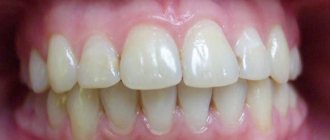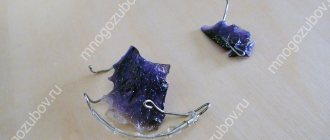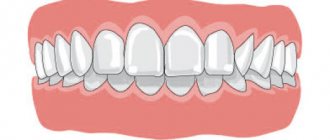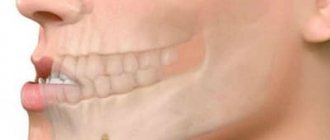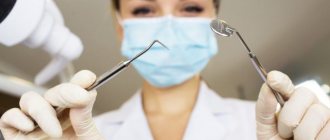All human teeth seem to be similar to each other. But the structure of the eye teeth, or fangs, as well as their appearance are very different from other species. For this reason, braces are often placed on fangs.
As for other teeth, each person has 4 types:
- front incisors - 2 pieces in one row of teeth;
- fangs - 1 in a row;
- premolars - 2 pieces;
- molars - 2 pieces.
So 4 dentitions make up 28 teeth; subsequently, in most people, 4 wisdom teeth are added to them.
What are each type of teeth?
Let's take a closer look:
- The incisors are the front teeth in the middle of the jaw. They only have one root. They have an external convex and internal, slightly concave surface, as well as small tubercles at the base. They are intended primarily for tearing food into separate pieces (biting off). Due to their sufficient weakness, they are practically not suitable for chewing.
- The canines follow in a row behind the incisors, located in the corners of the jaws. They are equipped with the longest root and crown, so they are quite strong.
- Premolars are located behind the canines. Their chewing surface is much wider and has 2 tubercles for chewing. Children do not have such teeth.
- Molars are the largest size. They are designed to grind food. There are three to five chewing tubercles on the surface.
Anomalies in the development of the dentition
Most often, if we consider all types of teeth, anomalies of an orthodontic nature occur in the canines. Many patients turn to specialists to correct the incorrect position of these teeth. Curvature of the fangs is observed in every third patient of orthodontists.
Types of curvature (dystopia) of fangs:
- fangs protruding from the jaws;
- hidden behind other teeth;
- very short or long;
- expanded;
- did not cut through completely.
The anomaly of the fangs “vampire smile” not only spoils the aesthetic side of the smile, but also interferes with the correct implementation of the function of eating. In this case, they seem to support the corners of the mouth. Braces can be a great solution to this problem.
Does it make sense to wear braces without removing teeth?
As we have found out, removal is required in cases where there is not enough space in the jaw for the correct arrangement of teeth. Unfortunately, without extraction in such situations, orthodontic treatment will be ineffective. The teeth, taking the desired position, will either be forced to shift their inclination, or simply will not budge. Only timely orthodontic treatment in childhood will help to avoid removal.
Publisher: Expert magazine about dentistry Startsmile.ru
Author of the material: Yaroslav Ikonnikov
Treatment options for canine dystopia
It is quite easy to determine canine dystopia. The complexity of its treatment depends on how advanced the disease is, the age of the patient and the nature of the anomaly.
Main methods of treatment:
- remove a wisdom tooth (when its growth is the cause of the anomaly);
- the use of braces (often you have to remove one of the teeth, usually a premolar, and then the canine is moved to the right place);
- installation of a prosthesis, or transformation of the first premolar into a canine (if it is missing in the row);
- reposition in more severe situations.
Note: The earlier treatment begins, the greater the likelihood that the patient will retain all teeth. For children under 12 years of age, removable plates are used for alignment, and teeth that are not fully formed are quickly aligned (in three to six months).
Teenagers aged 14-15 years old can benefit from braces very well without the need for surgical intervention, but in most cases such intervention is necessary for adults.
Distal bite: what is it and how does it happen?
This is an anomaly in which the lower jaw “retracts” to the rear position, and the upper jaw protrudes forward.
The defect may be mild and almost invisible. Or it turns out to be too obvious.
Braces correct distal occlusion, but you need to seek help from a professional who has many successfully treated clinical cases.
This violation is divided into types:
- Horizontal. The incisors of the upper jaw are inclined, raised towards the lip. The lower antagonists rest against the sky.
- Vertical. The upper incisors are inclined inward, often touching the gums near the lower ones.
The chin visually appears small. Doctors name several signs
, which indicate the severity of the pathology:
- There is a minor problem when the sixth upper and lower teeth are in contact.
- If closure is not observed, the unit ends up between the fifth and sixth antagonists, then urgent intervention is necessary and a long treatment process will be required.
The distal bite can be corrected and after wearing braces the profile becomes symmetrical and proportional.
Why can such teeth be crooked?
The canines are the last to erupt. They appear in a child at the age of 9-12, when all the other teeth have already erupted and taken a certain place. Sometimes there is simply no place for fangs in the dentition; it may already be occupied by another dental organ. Then the eye teeth can grow outside the dentition, dystopia is formed.
Another reason for the curvature of the fangs is their discrepancy with the size of the jaw. When a child inherits large teeth from one parent and a small jaw from another, canine anomalies occur quite often.
Anomalies can also be caused by untimely replacement of baby teeth with permanent ones.
How does alignment happen?
It usually takes 2 years to return the fang to its place with the help of braces.
It is important in such a situation to free up space for the fang by widening the jaw or getting rid of a poorly functional tooth.
If the second and fourth teeth are too close together, the quads are most often removed. When the fang only slightly protrudes from the dentition, removal is not required; in this case, it is enough to widen the jaw and at the same time move the dental organs to the right place.
Both regular metal braces and more aesthetic ones (lingual, ceramic, sapphire) can be used to straighten fangs.
It is important to start treatment as early as possible to avoid unpleasant consequences.
How does the process work?
On average, the process of returning the fangs to the correct position will take approximately two years. It has long been noticed that the appearance and profile of the face with and without braces for correcting fangs is significantly different. This is due to the functional load performed by canine teeth. In this case, the orthodontist faces the very important task of allocating free space for the fangs. To do this, as a rule, extra teeth are removed.
If there is not enough space between the second and fourth, then, as a rule, they resort to removing the fourth (or fifth, sixth) tooth. If a minor defect is visible in the protrusion of the fang from the general row, then removal will not be necessary. The bracket system will easily correct such a displacement. Braces expand the jaw and move the tooth into the desired position.
For fangs, ordinary metal braces and other more aesthetic materials (ceramic, sapphire and others) are used.
Is it possible to fix fangs without braces?
Many patients refuse to use braces. Reasons for refusal, in addition to the aesthetic component of this treatment method, may be the following:
- high cost of design and procedures related to treatment;
- long duration of treatment;
- difficulty to predict the result;
- long period of rehabilitation.
Fangs can also be corrected using other methods. Which one is better suited in a particular situation depends on the complexity of the anomaly and the age of the patient.
Correcting an overbite for children is much easier than for adults. Therefore, there are more ways to achieve this goal.
Alternatives to correcting fangs with braces in children:
- using mouth guards at night;
- the use of soft plates that are removable are quite easy to maintain, but treatment with them will take longer;
- trainers - have a targeted effect on problem teeth, are easy to use, and quite effective (since they are made for a specific defect, which can be corrected much quickly).
For an adult who has serious bite problems, it is better to use braces. Only in cases where the pathology is minor can other treatment methods be used. Such as:
- the use of removable aligners - does not affect the appearance of the smile, they need to be used for 1.5-3 years;
- veneers - used for minor pathology affecting only the appearance, if necessary, quickly correct it; These are thin plates attached to the teeth, do not cause discomfort, are almost invisible, but do not solve the problem itself, improving only the appearance.
The doctor decides whether to use braces to treat the bite or use alternative methods. After a thorough examination and obtaining the necessary results, he applies one or another method.
Whatever structures are used by the patient for treatment, he needs to constantly visit a doctor who will advise and monitor the correct course of the treatment process.
The patient had the following condition at the time of presentation:
In the case of our patient with a bite of molars “sixes” and “sevens” it is quite positive. The “eights” on the lower jaw were removed - it was their eruption that led to the displacement of the dentition and the appearance of such an unpleasant aesthetic imbalance in the patient’s smile. But everything can be fixed!
Displacement of the lower canines forward from the upper canines on the right and left
3rd class for canines on the right and left
Shift of the midlines due to the lower jaw to the right
Crowded position of teeth in the lower jaw
Lack of space for the lower right canine
And in general - narrowing of the dentition
Let me remind you that the main, basic desire of the patient is to avoid the presence of braces in the oral cavity.
As I wrote earlier, the patient wanted the treatment of crowded teeth to be as aesthetic and unnoticeable as possible, explaining that he was not ready to walk with glands in his mouth and be an “iron man” with iron structures in his mouth. Morally, at his young and active age, it’s hard, you’ll agree. After all, external, visible braces in this case are actually already “last century”, in the sense of technology of the last century, which has already been replaced by new, more advanced and effective technologies of the 21st century.
Based on the wishes of the young man, I proposed two options for treating crowded teeth and straightening canines using the following orthodontic equipment:
- Aligners
are transparent aligners, which are worn in the process of correcting the bite unnoticed by others. The aligners can be removed when eating and brushing your teeth.
- and lingual braces
- invisible braces that are attached to the inside of the teeth and are also not visible to others. But they are felt by the patient when worn. and removing lingual braces is not possible until the end of the entire treatment
Correcting the position of fangs with braces
Placing the fangs in the right place and aligning them takes 1-2 years of treatment with braces. This procedure sometimes requires removing one tooth from a row or widening the jaw, thus freeing up the necessary space. For minor curvatures, these procedures do not have to be resorted to.
You can use different braces to straighten your fangs: metal, ceramic, lingual or sapphire. It is better to carry out this treatment in adolescence. This way, the result will be achieved much easier and faster.
Braces can be installed only on the fangs, if there is no curvature of other teeth. It will take several years of treatment to straighten the fangs in such a situation.
You can straighten protruding fangs, depending on how severe the pathology is and its characteristics, in different ways.
Let's consider the average treatment option:
- First you need to cure all organs of the oral cavity, get rid of caries, plaque and stone.
- Then they examine the oral cavity, make impressions, and take x-rays. With their help, the structure is made.
- In order to free up space, the jaw is expanded if necessary or some teeth are removed.
- Next, the braces are installed.
- After the result is achieved, the braces are removed and retainers are selected for the patient. To secure the result, he will need to wear them for some time.
Treatment technique
For protruding fangs, a certain alignment technique was invented:
- Professional cleaning, which is recommended to be carried out by a hygienist. Here, plaque accumulated over many years is not only cleaned, but the health of the gums is also checked, the enamel is polished and the necessary recommendations are given.
- Sequential fixation of braces.
- Sliding the top row to obtain the necessary space.
- Moving the canines to the vacant space and stabilizing the incisors.
- Wearing orthoelastics, which provide good interdental contact. Wearing elastics is indicated 12 months after installing braces.
- Retention period.
The return of the dental fangs to the right place occurs in the fifth month of treatment. One of the arches holds the incisors in the correct position.
Pros and cons of orthodontic construction
Braces have the following advantages:
- With their help, you can cope with almost any jaw anomaly, regardless of the stage of curvature.
- There are practically no contraindications to their use.
- Already in the first months of treatment, the result is noticeable.
- Suitable for both adults and children.
- The installation procedure takes place exclusively in a dental clinic. The patient himself does not need to take them off and put them on, since the design is non-removable.
- The latest developments in braces are almost invisible to others.
Disadvantages of designs:
- The need for more thorough oral hygiene. In addition to teeth, braces also need to be thoroughly cleaned to prevent diseases such as caries, periodontitis and gingivitis from developing. This procedure should be performed after every meal.
- Long-term wearing design.
- Aesthetic side. Not all braces look attractive. But there are many of them that are practically invisible on the teeth (ceramic, lingual).
- High price when compared with other correction systems.
The second option for correcting malocclusion in children is elastopositioners.
Elastic positioners are a whole group of aligners. They are devices made of silicone. In appearance, they resemble boxing splints that athletes wear.
– Are these so-called myofunctional trainers?
– Yes, that’s absolutely right. You see, a trainer is more of a “proper name”, that is, a certain company has such devices that are called “trainers”. They can, of course, be called trainers, but it seems to me that it would be better to call them “elastic positioners”. That is, this is more of a collective name. What's the point? The fact is that these devices are made in an ideal bite, in the correct bite. Some of them have cells for the correct position of the teeth, that is, they work as guides. Some do not have these cells. But the point is that the elastopositioner, when worn by a child, trains the muscles to put the lower jaw in the correct position. As you know, our upper jaw is fixedly welded to the skull, it is impossible to move it, that is, the lower jaw, in fact, is responsible for the bite, how it relates to the upper jaw. And the position of the lower jaw is often determined by the condition of the muscles, because it is suspended by the muscles. And thus, elastopositioners work with muscles, they train the muscles to put the lower jaw in the correct position. The wearing mode is as follows for elastopositioners, the main recommendations are: two hours during the day and be sure to sleep in the trainer. So what are the advantages of elastopositioners?
There are four advantages of myofunctional trainers:
- The first advantage
is that the child is undergoing orthodontic treatment, no one knows, that is, this is a hidden orthodontic treatment. When treated with trainers, there are no problems with eating: to have a full meal, you just need to remove them. That is, neither taste buds nor the volume of the oral cavity are affected here, everything is normal. - The second plus
is that they are hygienic, that is, like the plates, they can be removed, the child can easily carry out oral hygiene, and nothing interferes with us. - The third advantage
is that they are relatively cheap and can be obtained fairly quickly, since they are purchased from dealer companies. - The fourth advantage
is that, due to the fact that they are made of silicone, elastopositioners are bioinert. Nowadays, the degree of allergy in the population is quite high, so, for example, in order to put a plate on a child, if we have a child with allergies, we often cannot do this, because the plastic still produces some residual monomers, which can contribute to an increase in the allergic background . Silicone is absolutely bioinert, so we can prescribe it to allergy sufferers, children with reduced immunity, and so on. This is their advantage.
What are the disadvantages of elastopositioners? There are two disadvantages:
- The first disadvantage
is that, again, since this is a removable device, you can either put it on or not. And this requires very high cooperation, both on the part of the child himself and on the part of the parents, because I personally always tell parents at my appointments: “It’s your job to stand over the child and force them to put on these mouth guards, to control how the child wears them.” and constantly remind him: put on the mouth guard, put on the mouth guard.” - The second disadvantage
is that, unlike plates, elastopositioners develop less force, so if, say, a child has a narrow jaw, then on the plate we can expand it much faster due to the fact that there are screws there. There are no screws here, here we simply select a larger device in a certain way so that it presses and expands the jaw.
The third
method of correcting the position of teeth in children, the next group of devices is
Failure Cases
Correcting fangs with braces is a procedure that leads to excellent results. But some patients refuse such treatment.
Let's look at the reasons for this refusal:
- Long term treatment, during which you need to wear braces.
- The procedure is quite expensive.
- Difficulties in predicting the final result.
- Long recovery period after treatment.
The choice is always up to the patient, and canines can also be corrected in case of refusal of braces using mouthguards, trainers or soft plates. But these types of treatments can only help at a young age; they are not suitable for adults.
Only with slight protrusion of fangs in adults can they be corrected using mouthguards.
Mouthguards are worn at night. Soft plates are much easier to maintain compared to braces, but the duration of treatment with their help is quite longer. Trainers are convenient and act on the existing defect in a targeted manner.
For adults, lumineers and veneers can also be an alternative to braces. They are placed on the back of the teeth. But their effect will only improve the appearance, without curing the disease itself.
Correction of bite in children
What is special about children? The fact is that children are a growing group of patients. Growing patients have high growth potential. What does this mean? The fact that we can influence the growth of one or another segment of the jaw, we can influence the change in bite most effectively, while in adults, since growth has already been completed, we can only actually work with that bite, with that position of the teeth, which is available. Therefore, the prognosis for children is much more favorable, on the one hand. In this material, we will first look at correcting the bite in young children, and at the end we will talk about modern possibilities for correcting the bite in older children, 15-18 years old.
A word from the dentists
Anna Ivanova, orthodontist:
From a medical point of view, the use of braces is primarily necessary to correct the bite and prevent the occurrence of diseases associated with this problem.
These designs are most effective in correcting jaw abnormalities. This is clearly noticeable when comparing the situation before and after treatment. In addition to a beautiful smile, they provide the patient with natural chewing function and speech. In addition, the use of braces has almost no contraindications.
Inna Mutasova, orthodontist:
Wearing braces should not embarrass an adult in any way, but crooked teeth and an incorrect bite are a sufficient reason for embarrassment. Don't miss the opportunity to have a perfect smile. Without braces, serious defects cannot be eliminated.
Now let’s imagine what would happen if the treatment of crowding began with lingual braces:
Yes, if the patient had rejected the aligners as a way to correct the bite, then, apparently, the choice would have fallen on lingual braces (considering that initially the patient did not want visible methods of correction)
When choosing lingual appliances as a treatment, I assume that the treatment would be more difficult for the patient.
Considering his increased anxiety and scrupulousness:
- he would not be able to get used to the violation of diction when wearing lingual braces (a lisp, which would definitely be present), and for him this would be a very important aspect associated with constant communication at work,
- he would not be satisfied with his oral hygiene, pain and discomfort when getting used to the braces system (more pronounced than the sensations with aligners),
- he would not be happy with the constant discomfort for his tongue.
Therefore, both the patient and I are very pleased with the aligners - our choice of treatment method and are satisfied with the results obtained!
Your orthodontist, Olesya Ageeva
Patient reviews
Alla, 30 years old
I agreed to install braces after the doctor said that if the bite is not corrected, I could subsequently lose all my teeth. The structures had to be worn for about two years. The result was truly a perfect smile. But after a while, the distances between the teeth became noticeable. It turned out that the dentist forgot to prescribe mouth guards. Now I wear them all the time, and my smile is gradually returning to normal.
Alexander, 41 years old
My son wore braces for almost 2 years. There were unpleasant sensations after installation and tightening. Could only eat liquid food. With the appearance of wisdom teeth, the teeth began to bunch up again. So, the effect of braces is there, but it is short-lived.
Olga, 26 years old
I had braces for over a year. It took me a long time to choose a clinic and a specialist who would install them for me. After installation, the unpleasant time of correction began. She devoted a huge amount of time to oral hygiene. I used all kinds of cleaning methods.
At the beginning of treatment, I experienced severe pain and was on painkillers. But now I’m just happy and very grateful to my doctor. The teeth are straight, the smile is almost perfect. The only thing is that I still wear mouth guards at night.

